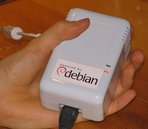Debian installer for plug computer

This page describes how to install Debian 12 (bookworm) on plug computers, such as the SheevaPlug and GuruPlug.
The following devices are currently supported:
- DreamPlug
- GuruPlug Server Standard
- GuruPlug Server Plus
- SheevaPlug (the SheevaPlug Development Kit)
- SheevaPlug with eSATA
- Seagate FreeAgent DockStar (limited support: only if you added a serial console)
Please read the plug variants page to find out about the status of other plug computers.
The Debian installer doesn't currently support installations to on-board flash storage, but you can use it to install to USB, SD or eSATA. In order to proceed, you will therefore need either a USB stick (or disk), an SD card or an external disk with an eSATA port.
Preparation
Make sure to connect an Ethernet cable to your plug computer (if you haven't already) because the installer will download files from the Internet for the installation.
Upgrading U-Boot
You have to upgrade the u-boot boot loader before you can install Debian. Please visit the page describing the u-boot upgrade process to ensure that you have the right version of u-boot before proceeding with the installation of Debian.
Starting the Installer
First of all, you have to download the installer. Download the uImage and uInitrd files and store them either on a USB stick, MMC/SD card or a TFTP server:
- DreamPlug: uImage and uInitrd
- GuruPlug: uImage and uInitrd
- SheevaPlug without eSATA: uImage and uInitrd
- SheevaPlug with eSATA: uImage and uInitrd
- Seagate FreeAgent DockStar: uImage and uInitrd
Now connect the install medium (USB stick, SD card or eSATA disk) to your
plug computer and connect a mini-USB connector in order to access the
serial console. Start your plug computer and a few seconds later you
should be able to connect to /dev/ttyUSB1 with 115200 baud. When you get
serial output, press a key to interrupt the boot process so you can load
the installer.
The instructions for loading the installer depend on where you want to load
the installer from. Also note that you may have to replace fatload with
ext2load in case you used the ext2 or ext3 filesystem on your USB stick
or MMC card.
Note for GuruPlug and DreamPlug users: MMC/SD cards show up as USB devices.
Therefore, if you're using a MMC/SD card, make sure to follow the
instructions for USB devices and not for MMC/SD. Furthermore, you'll have
to use a different device ID: 0:1 is the internal microSD, 1:1 the
external SD card and 2:1 an external USB device, like a USB stick.
- USB: If you stored the installer on a USB stick, please use:
usb start fatload usb 0:1 0x00800000 /uImage fatload usb 0:1 0x01100000 /uInitrd
- SD: for MMC/SD cards, use:
fatload mmc 0:1 0x00800000 /uImage fatload mmc 0:1 0x01100000 /uInitrd
- TFTP: if you want to load the installer via the network from a TFTP
server, use this:
Of course, you have to replace
setenv serverip 192.168.1.2 setenv ipaddr 192.168.1.147 tftpboot 0x00800000 uImage tftpboot 0x01100000 uInitrd
192.168.1.2with the IP address of your TFTP server.
Finally, start the installer:
setenv bootargs console=ttyS0,115200n8 base-installer/initramfs-tools/driver-policy=most bootm 0x00800000 0x01100000
The Installation
The installation itself should be pretty standard and you can follow the installation
guide. The installer knows about all supported plug computers and will
create a bootable kernel and ramdisk at the end of the installation. The
installer will also offer a partition layout that is known to work. If you
want to choose a different layout, make sure that you create a small (ca.
150 MB) /boot partition with the ext2 filesystem.
When the installation is done, you have to configure u-boot so it will automatically boot Debian. Interrupt the boot process of u-boot and enter the following commands. For USB, use this:
setenv bootargs_console console=ttyS0,115200
setenv bootcmd_usb 'usb start; ext2load usb 0:1 0x00800000 /uImage; ext2load usb 0:1 0x01100000 /uInitrd'
setenv bootcmd 'setenv bootargs ${bootargs_console}; run bootcmd_usb; bootm 0x00800000 0x01100000'
saveenv
If you're using an SD card, use these commands instead:
setenv bootargs_console console=ttyS0,115200
setenv bootcmd_mmc 'ext2load mmc 0:1 0x00800000 /uImage; ext2load mmc 0:1 0x01100000 /uInitrd'
setenv bootcmd 'setenv bootargs ${bootargs_console}; run bootcmd_mmc; bootm 0x00800000 0x01100000'
saveenv
Finally, use these commands to boot from eSATA:
setenv bootargs_console console=ttyS0,115200
setenv bootcmd_sata 'ide reset; ext2load ide 0:1 0x00800000 /uImage; ext2load ide 0:1 0x01100000 /uInitrd'
setenv bootcmd 'setenv bootargs ${bootargs_console}; run bootcmd_sata; bootm 0x00800000 0x01100000'
saveenv
The commands above use 0:1 to refer to your boot partition. This
indicates device 0 and partition 1. Depending on your configuration
and device, you may have to specify a different boot partition. Please
refer to the explanation on how to
find out your boot partition in case your device does not boot with
0:1.
Your plug computer is now ready to boot Debian from USB, SD or eSATA and it will automatically do so whenever you turn on the plug computer. You can now type the following command to boot:
run bootcmd
Additional packages
On the DreamPlug, you need the non-free firmware-libertas package for
WiFi and Bluetooth.